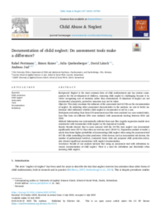Background: Neglect is the most common form of child maltreatment and has serious consequences for the development of children. Assessing child neglect is challenging because it involves recognizing acts of omission rather than commissions. If situations of neglect are not documented adequately, protective measures may not be taken.
Objective: This study examines the influence of the assessment tool SAT-BL on the documentation of neglect. By including other assessment characteristics in the analysis, we aim to better understand what influences whether child neglect is documented or not in a case.
Participants and setting: Data from 319 assessment case files were analyzed in a case-control study. Case files from six different CPSs were included with assessments starting between 2016 and 2020.
Methods: Information was systematically collected from case files. Logistic regression models were constructed with documented child neglect as the dependent variable.
Results: Results showed that in cases assessed with the SAT-BL tool, neglect was documented significantly more (50%) than when no tool was used (30.64%). Regression analysis revealed a nearly four-times higher probability of documenting child neglect when using the assessment tool SAT-BL while controlling for other predictors. Other factors, such as documented risk factors, the number of professionals involved, conducted home visits and proposed child protection orders, also showed significant associations with neglect documentation.
Conclusion: Results of our analysis indicate that using an assessment tool with definitions increases documentation of child neglect. There is a need for definitions and thresholds when assessing child neglect.

